Judge Lina Hidalgo
Presentation of the medal by Judge Lina Hidalgo of Harris County, Texas, to Valérie Maltaverne on Tuesday, 10 June 2025.
Texas - June 2025

“I had the most inspiring exchange with Chevalier des Arts et des Lettres (Knight of the Order of Arts and Letters) Valérie Maltaverne, founder of YMER&MALTA, and a true force in the world of design. Her work fuses old-world craftsmanship with cutting-edge materials, and her story is all about grit, reinvention, and vision. This is what cultural exchange looks like. Proud to connect Harris County’s creative spirit with artists like Valérie.”
Juge Lina Hidalgo
Cloé Pitiot
Historienne de l’art
Designer de grands projets de monuments au Centre des monuments nationaux, CMN
Valérie Maltaverne, Studio YMER&MALTA
Villégiature à l’Orangerie
Paris Design Week
Hôtel de Sully - 2025
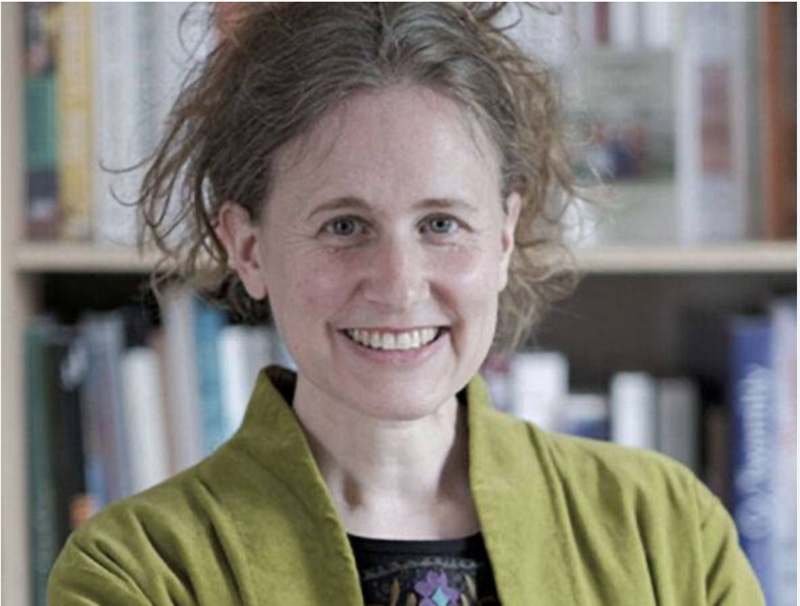
Invited by Paris Design Week to the Hôtel de Sully, Valérie Maltaverne founded her studio YMER&MALTA in 2008, in Paris. She chose to exhibit in the light-filled Orangerie, embracing the long timeframe: that of creation, but also of exchange and craftsmanship.
A woman of free and determined spirit, she has been exploring the boundaries of design for nearly twenty years, opening them to new horizons. Since her beginnings, after a career in film and audiovisual production, where she honed perseverance, teamwork, and a sense of storytelling, she has developed unique collections, orchestrated around the concepts of elegance and simplicity. Each of her pieces is a story in itself, gradually coming to life through collaborations with industrial designers and talented artisans, whom she guides toward new practices and unfamiliar territories.
In her projects, forms and lines evolve through a profound search for sensitivity and harmony; light, texture, and tonalities are, for her, fundamental.
The selection of works presented here, drawn from several of her collections, brings together at the Orangerie of the Hôtel de Sully both the excellence of traditional savoir-faire and the genius of cutting-edge technology. Often inspired by nature, the unusual and powerful pieces, oscillating between art and design, enter into dialogue with the garden and the remarkable architecture of the monument, each bearing witness to both the time of nature and the time spent in the workshops.
Her work is part of numerous collections, such as those of the Musée des Arts Décoratifs, the Musée National d’Art Moderne , The Centre Pompidou, and the Musée de la Chasse. Exhibited in New York, Shanghai, and at the Louvre Abu Dhabi among others, Valérie Maltaverne enhances the interiors of the greatest collectors.
Olivier Gabet
General Curator of Heritage and Art Historian, Director of the Department of Decorative Arts at the Louvre
The French-American Cultural Foundation: YMER&MALTA - Savoir-Faire et Innovation
Fine Art Museum, Houston - 2025
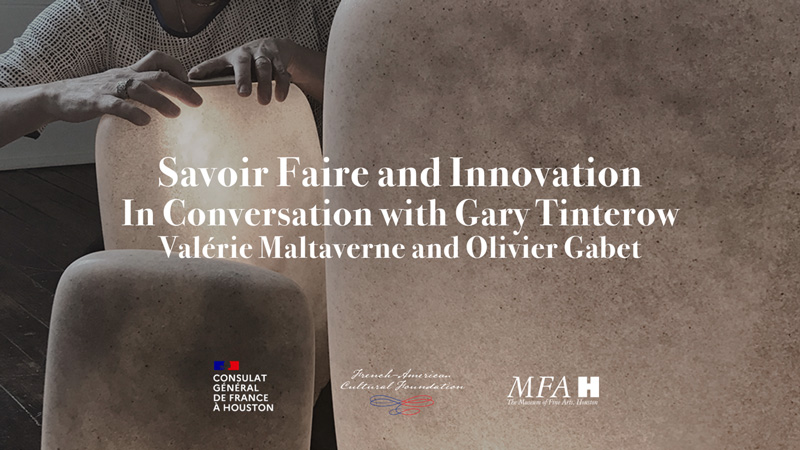
Today, craftsmanship is a profoundly universal value, positioned at the crossroads of tradition and modernity. But craftsmanship alone is never enough. To reach the highest expression of beauty, it must be nourished by aesthetics, by a cultivated sense of beauty, and by a true understanding of design. The creative process at YMER&MALTA embodies this perfectly.
For more than fifteen years, Valérie Maltaverne has developed a singular approach that strikes a delicate balance between craftsmanship and design, between technique and aesthetics. For each collection, she chooses a material or a technique as the common thread, guiding the creation of each piece—often in collaboration with various designers. Her vision unites these diverse proposals under a singular, unmistakable signature: YMER&MALTA.
France has a deep and enduring tradition of craftsmanship and design that powerfully echoes the history of the decorative arts, from medieval workshops to the marquetry of Boulle and pietra dura under Louis XIV, from Renaissance silversmithing and enameling to the royal and later national manufactories. In its own way, the YMER&MALTA design studio belongs to this long and rich legacy, driven by the same bold spirit of invention, research, and creative freedom.
Each collection is the result of dozens—sometimes hundreds—of sketches, samples, trials, and tests. Excellence requires tireless effort, but it also expresses that ultimate form of elegance known as sprezzatura, the concept born in Medici-era Italy and described by Baldassare Castiglione in his memorable Il libro del Cortegiano (1528): true elegance lies in doing something effortlessly. And this is precisely what YMER&MALTA achieves. In front of its creations, we experience beauty; we sense the effort behind their making, yet we do not feel it.
While it embodies a certain vision of French craftsmanship and design, YMER&MALTA is by no means confined to a French-only perspective. On the contrary, it draws inspiration from many cultures. Valérie Maltaverne is a traveler, a citizen of the world, nourished by her passion for landscapes and nature walks, by the South American mountains and the granite rocks of Brittany, by trees and wildflowers, by her love of African cultures and Japanese art. She offers a personal translation of her visual world into objects of design—objects of desire. This explains her drive to push boundaries and her ability to challenge the designers and artisans who collaborate with YMER&MALTA design studio belongs to this long and rich legacy, driven by the same bold spirit of invention, research, and creative freedom.
Over the past ten years, YMER&MALTA has been both championed by collectors and acclaimed by museums and cultural institutions, with an impressive track record—an apt expression for Valérie Maltaverne, who began her career in a completely different field: the film industry. This background helps explain her strong sense of narrative and scenography. Every collection tells a story.
Two collections have emerged from her close collaborations with major art institutions: the AKARI UNFOLDED collection with the Noguchi Museum in New York, and THE GREAT LADY with the Cité Internationale de la Tapisserie in Aubusson. Out of 100 original creations by YMER&MALTA, 63 have been exhibited in museums, and 27 have been acquired by institutions such as the Centre Pompidou, the Musée des Arts Décoratifs, and the Centre National des Arts Plastiques—landmark institutions for design and the applied arts in France.
With her roots in the film industry, Valérie Maltaverne knows how to build a narrative. She dreams big. Around a material—marble, marquetry, leather—she invents new worlds to discover. Around a place, she dares to tell incredible stories—such as the memorable tale of THE GREAT LADY, created with Aubusson, the historic epicenter of tapestry and a jewel of French craftsmanship. A series of objects and furniture evokes an enchanted fairytale, where princesses encounter deer and bears in a poetic realm of imagination.
Alexandra Deutsch
Director of Collections at the Winterthur Museum, Baltimore
The French-American Cultural Foundation: YMER&MALTA - Savoir-Faire et Innovation
La Maison Anderson, Washington - 2024

Valérie Maltaverne is the founder and artistic director who leads YMER&MALTA, a bespoke design studio that embodies the essence of savoir-faire in everything it produces.
She merges the best of the past with a contemporary vision, crafting a unique narrative for each piece YMER&MALTA creates.
Excellence in materials, innovation in design, and an unwavering commitment to exceptional, timeless art objects and furniture fuel Maltaverne’s distinctive vision.
Her determination to revive the most refined techniques of French craftsmanship drives the boundless energy she pours into every YMER&MALTA collection.
Founded in 2009, YMER&MALTA has elevated the creation of art furniture, rugs, and utilitarian objects to the level of bespoke haute couture.
Working with more than 30 artisans to bring her collections to life, Maltaverne draws inspiration from nature and poetry. She compromises on nothing.
Her insistence on uniting excellence in craftsmanship, design, and materials in fully functional pieces is proof that the finest contemporary art furniture and decorative arts can exist in homes as well as museums.
“Neither time nor cost determines our products.
They are finished when my vision is realized,” explained Maltaverne.
These are the words of a visionary whose embodiment of savoir-faire comes to life in everything YMER&MALTA creates.
Hervé Lemoine
Président of the Mobilier national
Collection Eidos XXI - 2022
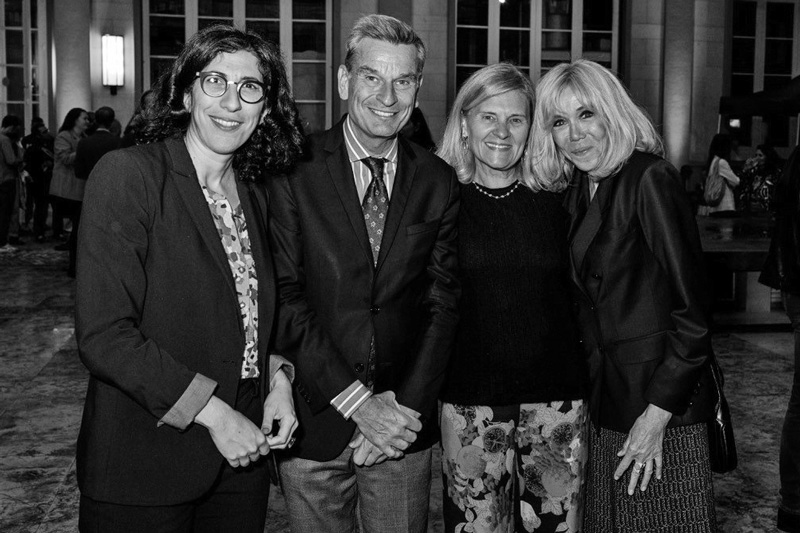
By presenting this ensemble conceived by YMER&MALTA and the designer Benjamin Graindorge and realized within the Atelier de Recherche et de Création (ARC), the Mobilier National is reviving the French tradition of designing and decorating living spaces.
The aesthetic harmony and functional coherence of this project is also part of a history, that of the French decorative arts. By entering the national collections, it joins four centuries of excellence and creativity.
The EIDOS XXI ensemble was made possible thanks to the talent of its designers and the know-how of the ARC, which allows designers to study and develop their most subtle ideas, in contact with art technicians gifted with a high level of expertise. More than ever, the Mobilier National wishes to experiment and promote creative innovation in design and craftsmanship.
Franck Riester
Minister of Culture
Ceremony of the Order of Arts and Letters – 2020
Speech by Franck Riester, Minister of Culture, delivered on the occasion of the ceremony to award Valérie Maltaverne the insignia of Chevalier of the Order of Arts and Letters, Wednesday, January 8, 2020.
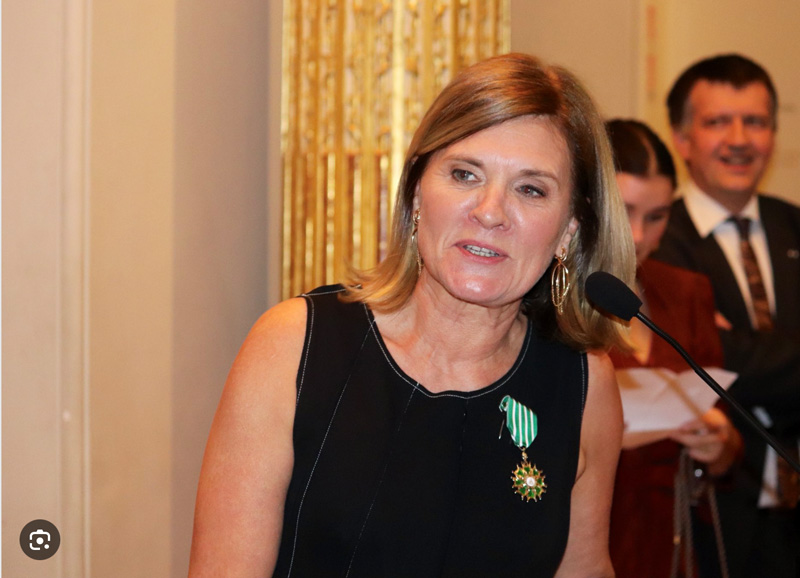
Minister, dear Renaud Dutreil,
Director General, dear Sylvie Correard,
Deputy Director General, dear Olivier Gabet,
Ladies and Gentlemen,
Dear Friends,
Dear Valérie Maltaverne,
What a pleasure to be with you this evening to express France’s gratitude for your career!
Thank you to the Musée des Arts Décoratifs, whose Director General, dear Sylvie Correard, I salute for hosting us this evening. And thank you, dear Olivier Gabet, for honoring Valérie Maltaverne and her work. Thanks to you, tonight we discover the latest creations from the Ymer&Malta studio, which are remarkable in many ways—as you just pointed out, Mr. Chief Heritage Curator, dear Bruno Ythier.
Dear Valérie Maltaverne, this collection dedicated to the art of tapestry is the culmination of a long collective effort that you have led with all the commitment, freedom, and rigor that characterize you.
As in your previous collections, these creations were born from a fruitful dialogue with great designers and artisans. Profoundly visionary, they elevate furniture to the rank of art.
“Any material, any idea that is embodied unhindered in space” can be considered sculpture, said Isamu Noguchi—one of whose iconic works you brilliantly reinterpreted for the exhibition “Akari Unfolded” at his museum in New York.
Conceived as objects for life, the pieces you imagine are works that explore the infinite potential of this art of material and space that is sculpture.
The originality and technical excellence that characterize your creations are the result of the exceptional work you carry out with determination, passion, and meticulousness.
This creative impulse that drives you first led you to film production, particularly animated works.
During your career in this sector, your energy, ambition, and sense of challenge have already impressed everyone around you.
Determined to bring innovative projects to fruition, you notably managed to rally the necessary support for the production of a series of fairy tales revisited by great artists such as Moebius and Cabu.
This work, which freed itself from the constraints usually imposed by television, was critically acclaimed. It’s emblematic of your audacity and your irresistible ability to find ways to lead artists to new lands.
Just over 10 years ago, you decided to dedicate yourself to a new mode of expression.
By creating your Ymer&Malta studio with Rémy Le Fur, you gave yourself complete freedom to forge your own path in the world of design.
As artistic director of this unique structure, you are at the heart of the collective adventure that is creation. An outstanding leader, you retain from your experience as a producer a sense of risk and a taste for long-term work, from the budding of an idea to the final stages of its physical realization.
Taking time is one of your essential requirements. It reflects your radical refusal of any shortcuts or cheating in your absolute quest for perfection.
For you, creation always begins with a challenge. With your intuition as your only guide, you take the byways without ever seeking to conform to current trends.
Creating is, above all, researching, exploring, and imagining new ways to give substance to a vision that itself continues to enrich itself through experimentation.
This is why your works display such singularity and originality, reflecting the sincerity and freedom of your artistic approach.
We owe it to you for revisiting marble, to which you have given a lightness of touch.
But also for breathing new life into marquetry, in the highly acclaimed “feu de tout bois” collection, which ushered in a new era this technique, which remained inextricably associated with the art of André-Charles Boulle.
And today, this magnificent collection dedicated to Aubusson tapestry confirms your ability to reinvent the exceptional skills that are part of our shared heritage.
Thanks to your work with the designers and weavers who are the guardians of this technique, you have pushed the boundaries of the art of tapestry. Thank you, dear Valérie Maltaverne, for keeping these traditional skills alive by placing them at the heart of contemporary creation.
By directing the creative process like an orchestra conductor, you demonstrate a formidable ability to bring out the best in each of the designers and artisans who contribute to the conception and creation of your works.
By conveying to them the conviction that drives you, you inspire them to take a fresh look at their technique and explore new paths.
You have thus helped to uncover young talents, such as Benjamin Graindorge, Sylvain Rieu-Piquet, and Sébastien Bergne.
Thank you for sharing your inspiration with so many creators.
This inspiration is largely based on your relationship with nature.
The attention you pay to exceptional natural materials, as well as the organic lines of the pieces you create, demonstrate a deep respect for the beauty of nature revealed in your art.
Your “Fallentree” bench, currently on display at the Louvre Abu Dhabi, perfectly embodies the poetry of the essential that your creations express.
How, then, can we not recall the words of Constantin Brancusi, who stated that the artist achieves simplicity “by approaching the real meaning of things.”
Yes, it is indeed this simplicity that characterizes your creations. A simplicity synonymous with perfection, for it is the true expression of a vision refined through research and experimentation.
Dear Valérie Maltaverne,
This total commitment is not limited to creation. Your passion and enthusiasm accompany you at all times in life. Particularly in your travels, where you love to immerse yourself in other cultures, and at parties, which you brighten with your infectious energy.
Everyone you have gathered here tonight knows your authenticity and your sincerity. They know the tenacity you can demonstrate when it comes to achieving something you believe in.
I also wish to extend a warm thought to your husband Bernard, whom I greet, as well as to your two daughters Joséphine and Louise, who are also present this evening. I know how invaluable your family’s support is in your daily life, punctuated by creative work.
Dear Valérie Maltaverne,
Before all those you have gathered this evening, your loved ones, your friends, those who matter in your art and your life,
At the Musée des Arts Décoratifs, a national institution which, like others, has included some of your works in its collections in recognition of their remarkable quality,
For your unique and innovative contribution to the vitality of French design and crafts,
For all you have already done, and all that remains to be accomplished, We make you a Knight of the Order of Arts and Letters.
Olivier Gabet
Directeur Musée des Arts décoratifs de Paris
Le Studio YMER&MALTA - 2020
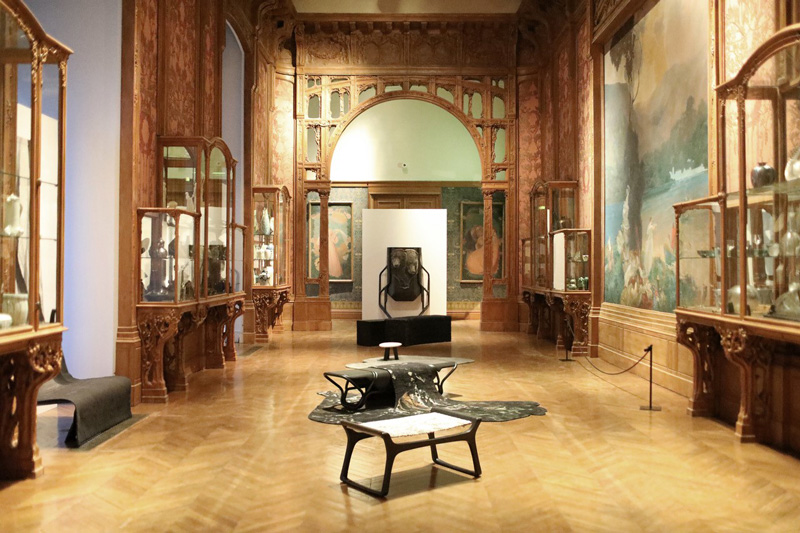
Almost under the radar, far from commercial pressures, the Parisian design studio YMER&MALTA has garnered extraordinary recognition from major institutions in recent years. Its two most recent collections were commissioned by museums: “AKARI UNFOLDED” for the Noguchi Museum and “THE GREAT LADY” for the Cité internationale de la Tapisserie d’Aubusson. Of the 100 pieces produced by YMER&MALTA over the past decade, 60 have been exhibited by museums and 20 have been acquired as part of their permanent collections, such as the Musée des Arts Décoratifs in Paris, the Centre Pompidou, and the CNAP (Centre National des Arts Plastiques).
The key to the Studio’s success is the extraordinary project led by its creative director, Valérie Maltaverne, who, 10 years ago, began revolutionizing, one by one, the techniques historically used in the decorative arts—marble, glass, leather, wood marquetry, lighting, tapestry—in order to create new design universes for the 21st century.
Challenging the boundaries of a centuries-old craft is no easy task: the reinvention required to create never-before-seen objects requires years of experimentation with new technologies or new forms of use. Above all, it requires a close and patient collaboration between the studio director and the artisans.
For each material and collection, the process begins with a concept formulated by Valérie Maltaverne. This concept is proposed to industrial designers. Valérie discusses with them until the perfect design is achieved: this phase can last more than a year. Then begins the sourcing of talented artisans who will be passionate about projects that challenge the limits of their skills. When the Studio works on developing new techniques, it often takes two to five years of research and experimentation to create the “perfect” piece that will be integrated into collections and serve as a technical basis for special commissions.
In France, the Cité Internationale de la Tapisserie d’Aubusson, whose tapestries have been a source of national pride since medieval times, and whose 20th-century chapter was marked by Jean Lurçat, commissioned YMER&MALTA to develop a brand new collection, which was unveiled in January 2020 during a private presentation at the Musée des Arts Décoratifs in Paris, on the occasion of the presentation of the insignia of Chevalier des Arts et des Lettres to Valérie Maltaverne by the Minister of Culture. Never before has tapestry been part of contemporary furniture in such an innovative and poetic way, as Bruno Ythier, Chief Curator of the Musée de la Tapisserie d’Aubusson, noted in his presentation.
YMER&MALTA pieces are historical in the truest sense of the word.
Cloé Pitiot
Curator, Musée des Arts Décoratifs de Paris
Valérie Maltaverne, founder and artistic director YMER&MALTA - 2020
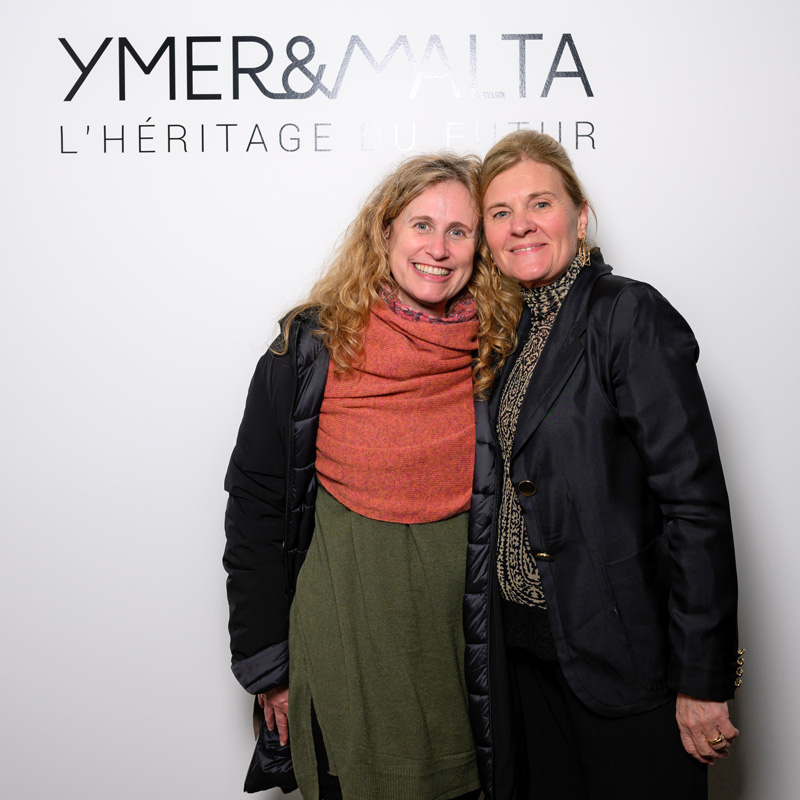
“Combining traditional art professions with cutting edge innovation, YMER&MALTA gives fresh, innovative impetus to the French cultural Heritage.”
Her creations reflect her generosity. They are works realized with four hands and two brains. Valerie knows how to lead people towards a goal, and she knows how to do it in the most generous manner. As she drives the creative process, she remains open to ideas, to dialogue. She is not just a creative director.
There is always an exchange between the designer, the craftsman, the curator. She is an avid discoverer. She doesn’t wear just one hat. She is a creator whose profile is unlike any other. Today, this way of working doesn’t exist anymore. One has to go back to the studio of Eileen Gray, or that of fabled design houses to find this type of creative process. She learns while working with the craftsmen.
Born from the tortured soul of its creator, her pieces are both powerful and light. She suffers along the way in search of perfection, as all artists do. She never lets go and the result shows it. She dwells in emotion and sincerity. She looks for the soul in everything and everyone, and her relationship with her furniture pieces is truly an intimate one.
Bruno Ythier,
Curateur en Chef du Patrimoine,
La Cité Internationale de la Tapisserie
Collection: La Tapisserie d’Aubusson
The Great Lady - 2020
We’re in Switzerland, Saint Moritz, Davos or Crans Montana in a chalet on the edge of a large ski-resort. The landscape is majestic, and the distinctive, lavish wooden architecture seems to hang from the slopes of the Valais or Grisons Cantons.
The metallic reflections from the snow give the twilight an incomparable radiance, and the owners of the chalet have filled their living space with unique, precise, yet warm pieces. In the living room, an elegant, two-seater sofa provides the vision of a misty undergrowth. The structure is almost invisible and the woven upholstery depicts a winter forest scene with the utmost delicacy; the upward thrust of the trunks brings strength while the wool sublimates the way the mist delicately blends the barks with the moss and lichens. A bench, in front of the chimney, gives an impression of burnt wood while the tapestry catches the eye with its clear, precise design like a calligraphy, belying the generous, sensual feel of the warm,comfortable material. Up against the bedroom wall, we find a console in a novel material, infinitely rich in texture, that can be seen as a micro landscape, unless you prefer to stand back and take it to be the map of a garden… The Cabinet comes with a tapestry of a bear, a mass of energy with living threads that remind us that the precious wooden structure was once a massive, towering tree. The textile skin is redolent of the fur detail painted by Géricault and the bestiality reminds us that wool comes from animals, providing us with as much warmth and strength as softness. And what can we say about this strange, mossy yet mineral carpet; water gushing from a rocky crevice or from compacted ice down thegreen slopes, announcing the arrival of summer. We can only quote Baudelaire, “There all is order and beauty, Luxury, peace, and pleasure.” In his poem Invitation to the voyage, he dreams that: Gleaming furniture, / polished by the years, / Will ornament our bedroom. The next room in the chalet has its own share of treasures: Another timeless, brilliant bench features a cover as if seen from above, like a hand drawn by Le Corbusier, a hand holding up a subtle, textured landscape of dark colors, fire and shadows, as the warmth of the wool contrasts beautifully with the quiet, round shapes of the base. The tapestry lands like a comfy cashmere shawl on the back of an armchair, rearranging the motif with curves and counter-curves. Further on, last but not least, a small, shiny wooden stool comes topped with a herd of sheep packed together, not unlike a close-up from Artavazd Pelechyan’s unique film, The Seasons. The skilled tapestry work that combines form and function, doesn’t just dress the seat, it actually forms the seat on this apparently simple yet intriguing piece. Motif and use blend together on this tautological piece where subject and material form a whole.
Piece by piece, with subtle newcomers and brilliant adaptations, the pertinence of the choices, materials and forms from YMER&MALTA renew and transcend centuries of the crafts of weaving, cabinet-making and tapestry-making. With regard to the work of YMER&MALTA, a quote from André Véra seems appropriate for these pieces: Happy is he who loves his time: he truly enjoys his day.
To create a feeling of a collection as a whole but respecting the tiniest detail of each piece, requires energy, a keen eye and strong, precise artistic direction, all of which YMER&MALTA brought to the table, while bringing the tradition of furniture tapestry back to life. The vision
was clear: furniture as singular pieces, designed in the tradition of the collective that was so dear to the decorative movements in art history: no carpet without a bench to place on it, no lamp without a desk. Each stage came with the same high expectations: Valérie Maltaverne overturned the traditional relationship between the artist, the source of the creative process, and the weaver, the source of the craft needed to bring the piece to life. She intervened, taking over the relationship and greatly enhancing an already fertile dialogue. She constantly demanded more for the project from each designer; everything was outlined, nothing was left to chance. She got involved in the materials, making them an integral part of the project.
Valérie’s relationship with the master weavers could be termed textile interpretation. She sent mood boards, with unexpected pictures, to the workshops, feeding their imaginations, pushing the limits of the art-artisans’ inventiveness. Valérie created an active complicity that was both intense and tense at times, forcing the artisans to dig deep in terms of technique. She made them take chances, research old techniques, try things out, use types of weaving that are usually used in other circumstances, in short, she set up a birthing process that sublimated the intelligence of their movements, the materials, the textures and the colours. Her iterative approach, first with the designer, then with the artisan, pushed the envelope on design, materials and techniques. The weavers, in turn, had to drive their suppliers, such as the spinners and dyers, ever further. This stirred the entire immaterial cultural heritage (Aubusson was added to the UNESCO list in 2009) of Aubusson tapestries into giving its very best to serve the sure-footed vision of this collection.
This new collection sees YMER&MALTA studio bring back the tradition of World Fairs and their pavilions as they were until the Second World War. Examples include the Ruhlmann collection hotel and the French Embassy pavilion by the Société des artistes décorateurs in 1925 and of the International Exhibition of Modern, Decorative and Industrial arts in 1925. François Carnot, the then President of the Union Centrale des Arts Décoratifs, wrote at the time: each object must, as far as is possible, form part of a logical, consistent whole. These pavilions beautifully combined inventiveness, subtlety and refinement, and YMER&MALTA’s collection of tapestry furniture designed for a ski chalet does the same.
The Cité de la Tapisserie is indeed proud to see this collection take form. This was an unusual project as the Cité commissioned a gallery, not an artist, delegating the creation of a collection of pieces to a challenging, exacting private entity. The expectation was that this would produce interesting work. The studio did not disappoint, bringing together a who’s who of the best young designers with exceptional artisans. The YMER&MALTA at Aubusson project, turned out be a technical and aesthetic adventure for the weavers and the entire sector, the likes of which have not been seen since the big furniture commissions of Süe et Marre, Charles Dufresnes, Maurice Dufrène and Paul Follot.
YMER&MALTA studio did more than just mobilise and work with the immaterial heritage of Aubusson tapestry, it enriched the whole process.
Emmanuel Gérard
Director of the Cité Internationale de la Tapisserie
Collection: La Tapisserie d’Aubusson
The Great Lady - 2020
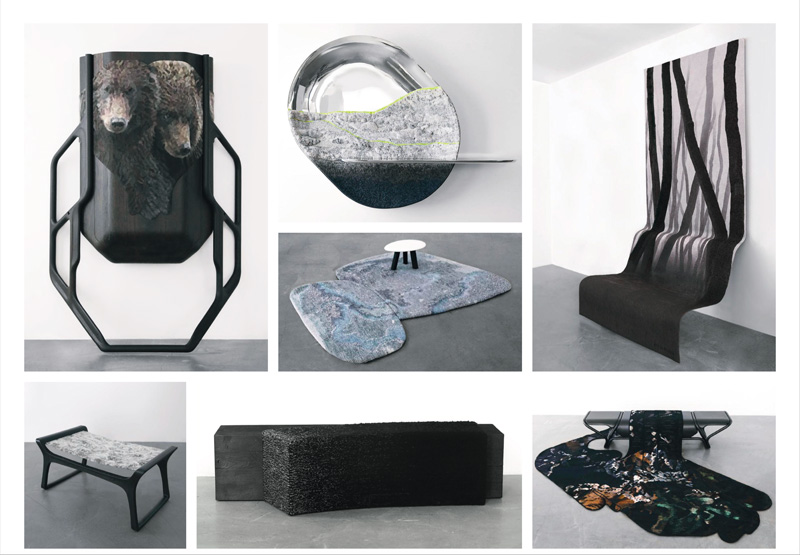
With this collection, the Cité Internationale de la Tapisserie d’Aubusson, in tandem with YMER&MALTA studio, explores a new area of contemporary design. A public-private venture, this collection represents an integral part of the development project to raise awareness of the exceptional craftsmanship of Aubusson tapestry, that has been ongoing since 2010.
This world-renowned heritage boasts a rich history that is far from finished, with an image that is indeed noble, if at times considered to be backward-looking. The policy of contemporary creation that is currently being implemented by the Cité allows contemporary artists and designers to blend their work with this great heritage, and is aimed at making people in the industry and the general public change the way they look at Aubusson tapestries.
This highly innovative collection, put together by YMER&MALTA studio, is a collection of seven pieces of furniture that feature Aubusson tapestries. Valérie Maltaverne, who runs the studio, worked, not only with her team of designers, but also on the implementation of an unprecedented collaborative process alongside the weavers at Aubusson to produce new textures, encouraging craftspeople to use their unique knowledge to take their technical know-how to places unknown.
Creating a new conversation for Aubusson Tapestry is also enriching for the student- weavers working toward the Brevet des Métiers d’Art in the Cité internationale de la Tapisserie, who will take these new techniques and build the tapestry-making of the future.
Dakin Hart
Senior Curator at The Noguchi Museum - New York
Collection: AKARI UNFOLTED - 2018
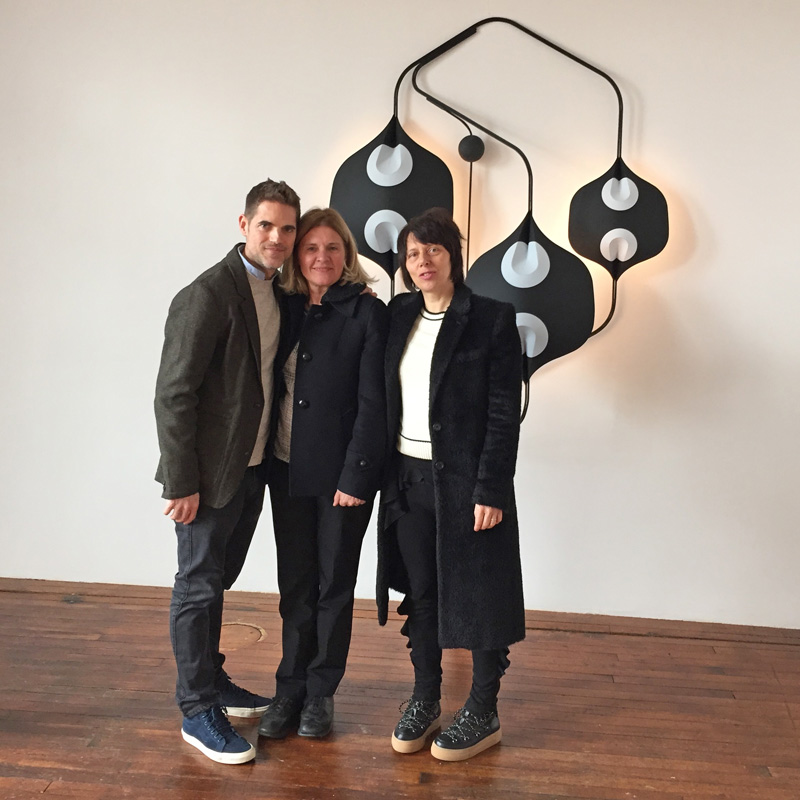
Over the last decade, YMER&MALTA has breathed new life into French savoir faire, the centuries-old craft disciplines that form the backbone of France’s luxury goods industry.
The key to the firm’s extraordinary artistic success has been founder Valérie Maltaverne’s ability to marry an intimate respect for these craft traditions—and the art of living that they represent—with a creative desire to see them evolve: not merely by keeping up with contemporary taste, but through the incorporation into their core of new technologies and ideas.
Maltaverne’s fundamentally collaborative methodology combines aspects of film production (a previous career), the artisanal workshop, and Silicon Valley startup- style collective risk-taking. YMER&MALTA employs multiple designers (emerging and established) and artisans (traditional and state of the art), with whom Maltaverne works in the role of auteur. Everything that YMER&MALTA produces is an expression of her determination to synthesize the old and the new by innovating from within the values of a given craft tradition.
The small battery-powered “Belle de Nuit” event light exemplifies this hybridity. Maltaverne fell in love with the raw plastic 3D-printed prototypes they made in the course of working out the shape of the larger “Belle de Jour” and decided to have them produced in rough (digital) and smooth (traditional) versions in fine porcelain in a Paris garage by a former Sevres master ceramicist.
The American sculptor and designer Isamu Noguchi (1904–88) described his own anti- nostalgic engagement with premodern material cultures as the true development of old traditions. Akari light sculptures, his most complete and important expansion of the envelope of sculpture and the apotheosis of his efforts to give the past a new future, was, like Maltaverne’s work in savoir faire, a synthesis of craft and industry.
Noguchi often prototyped new lantern shapes in styrofoam—lightweight, cheap, and easy to carve— producing horrible crumbly models that epitomize what we would now describe as the dark side American consumer culture. These models were shipped to Japan, where master craftsmen translated their contours into the collapsible wooden frames that are used to make Akari. The principal innovation in Noguchi’s Akari, however, was seemingly the most obvious. All it took to bring the traditionally candle-powered paper lantern into the twentieth century was to electrify it. With the (then heretical) combination of the electric light bulb, the symbol of modernity, and washi paper, Noguchi created timeless lamps with the life-force of natural light.
For nearly two decades, the most sensitive, daring, and sympathetic Akari retailer in the world was Steph Simon Gallery in Paris (1956–74), best-known for introducing and championing the designs of Jean Prouvé and Charlotte Perriand. Thanks to Simon, Akari have had an especially strong impact on design in France. Maltaverne is among the many French designers who bought them there and have lived with and been motivated by them.
The present project, YMER&MALTA’s first to reach outside French craft, came out of a 2016 visit to The Noguchi Museum during which Maltaverne was inspired to apply her model to Akari. The challenge was to see whether she might, treating Akari as the traditional craft, extend its fundamental alchemies—what Noguchi called the intrinsic qualities of craft whose products cannot be successfully falsified (as the many Akari knockoffsdemonstrate)—into the era of the LED.
Ultimately, YMER&MALTA’s modest plan to produce six designs informed by Akari principles developed into a massively complex international collaboration with six designers, and artisans in more than 20 different disciplines. Overcoming many technical hurdles, they pushed linen, metal, resin, Plexiglas, concrete, and paper in new directions and produced 29 light fixtures—which now join Noguchi’s radiant, ever-expanding legacy.
Cloé Pitiot
Design Director, Centre Gorges Pompidou
YMER&MALTA - 2018
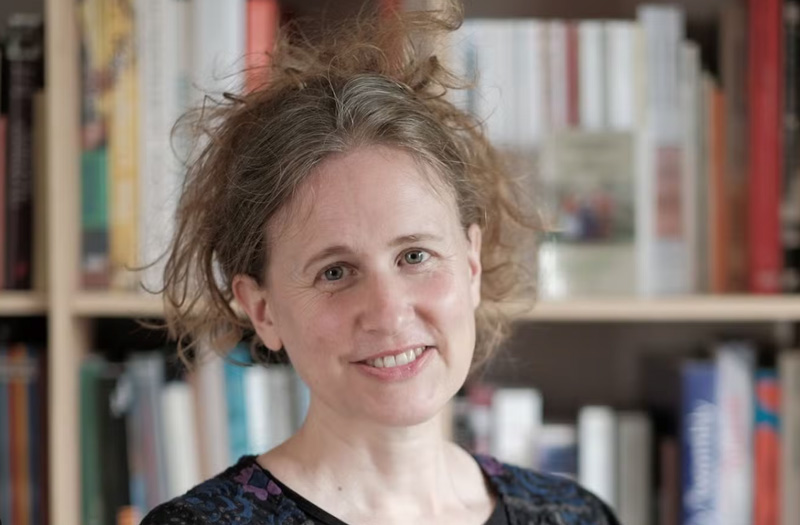
YMER&MALTA occupies a very special place in the world of furniture, at the crossroads of design, art and craftsmanship. Thanks to traditional know-how combined with highly contemporary innovation, YMER&MALTA creates timeless, limited-edition pieces for an audience of aesthetes and connoisseurs.
It opens up a new avenue of expression at the crossroads of art and craft and modernism, between savoir faire and innovation, combining the rigor and sobriety of the line with the virtuosity and freedom of the precise gesture of the craftsman or the numerically controlled machine.